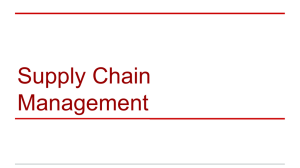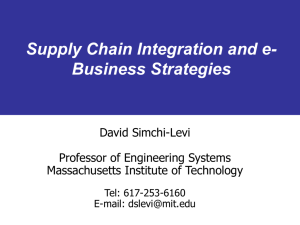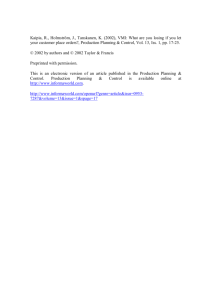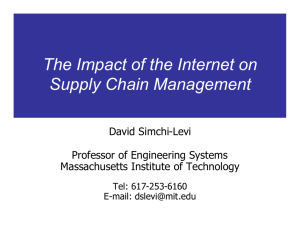Information Flow in Supply Chain Management
advertisement
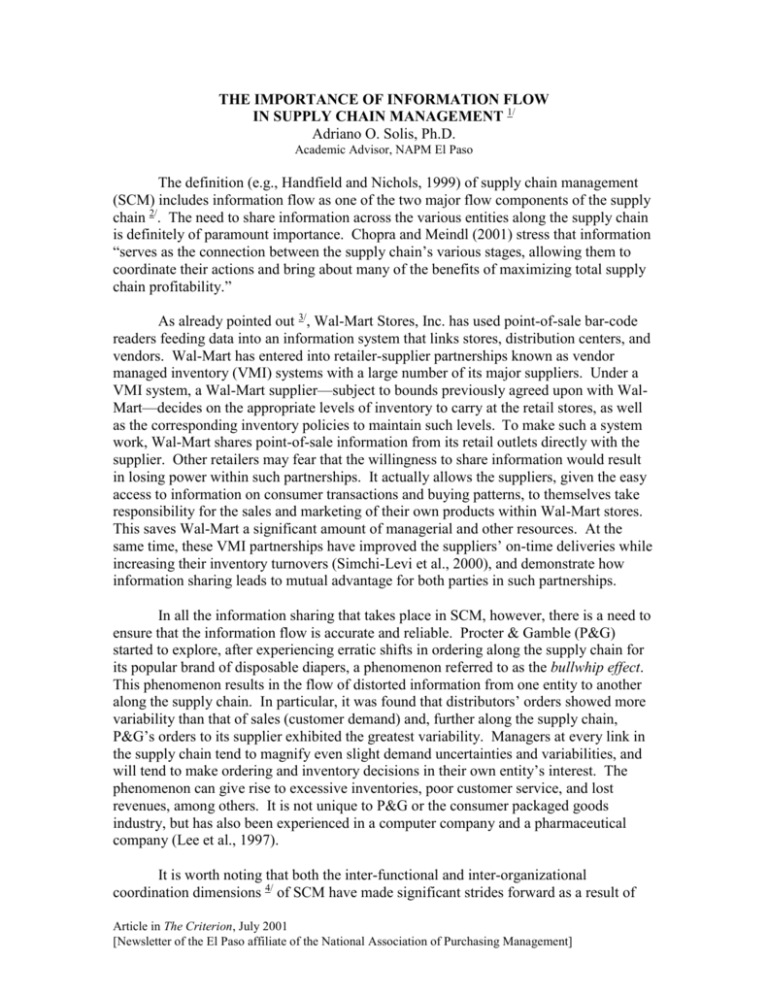
THE IMPORTANCE OF INFORMATION FLOW IN SUPPLY CHAIN MANAGEMENT 1/ Adriano O. Solis, Ph.D. Academic Advisor, NAPM El Paso The definition (e.g., Handfield and Nichols, 1999) of supply chain management (SCM) includes information flow as one of the two major flow components of the supply chain 2/. The need to share information across the various entities along the supply chain is definitely of paramount importance. Chopra and Meindl (2001) stress that information “serves as the connection between the supply chain’s various stages, allowing them to coordinate their actions and bring about many of the benefits of maximizing total supply chain profitability.” As already pointed out 3/, Wal-Mart Stores, Inc. has used point-of-sale bar-code readers feeding data into an information system that links stores, distribution centers, and vendors. Wal-Mart has entered into retailer-supplier partnerships known as vendor managed inventory (VMI) systems with a large number of its major suppliers. Under a VMI system, a Wal-Mart supplier—subject to bounds previously agreed upon with WalMart—decides on the appropriate levels of inventory to carry at the retail stores, as well as the corresponding inventory policies to maintain such levels. To make such a system work, Wal-Mart shares point-of-sale information from its retail outlets directly with the supplier. Other retailers may fear that the willingness to share information would result in losing power within such partnerships. It actually allows the suppliers, given the easy access to information on consumer transactions and buying patterns, to themselves take responsibility for the sales and marketing of their own products within Wal-Mart stores. This saves Wal-Mart a significant amount of managerial and other resources. At the same time, these VMI partnerships have improved the suppliers’ on-time deliveries while increasing their inventory turnovers (Simchi-Levi et al., 2000), and demonstrate how information sharing leads to mutual advantage for both parties in such partnerships. In all the information sharing that takes place in SCM, however, there is a need to ensure that the information flow is accurate and reliable. Procter & Gamble (P&G) started to explore, after experiencing erratic shifts in ordering along the supply chain for its popular brand of disposable diapers, a phenomenon referred to as the bullwhip effect. This phenomenon results in the flow of distorted information from one entity to another along the supply chain. In particular, it was found that distributors’ orders showed more variability than that of sales (customer demand) and, further along the supply chain, P&G’s orders to its supplier exhibited the greatest variability. Managers at every link in the supply chain tend to magnify even slight demand uncertainties and variabilities, and will tend to make ordering and inventory decisions in their own entity’s interest. The phenomenon can give rise to excessive inventories, poor customer service, and lost revenues, among others. It is not unique to P&G or the consumer packaged goods industry, but has also been experienced in a computer company and a pharmaceutical company (Lee et al., 1997). It is worth noting that both the inter-functional and inter-organizational coordination dimensions 4/ of SCM have made significant strides forward as a result of Article in The Criterion, July 2001 [Newsletter of the El Paso affiliate of the National Association of Purchasing Management] developments in the field of information technology, particularly the growth of interorganizational information systems. Enterprise resource planning (ERP) systems 5/ have facilitated inter-functional coordination. The wide use of electronic data interchange (EDI)—the direct computer-to-computer exchange between two business partners of standard business documents such as purchase orders and invoices—especially over the last ten years or so, has helped improve inter-organizational coordination in SCM. References Chopra, S. and Meindl, P. (2001). Supply Chain Management: Strategy, Planning, and Operation, Prentice-Hall, Upper Saddle River, N.J. Handfield, R.B. and E.L. Nichols, E.L., Jr. (1999). Introduction to Supply Chain Management, PrenticeHall, Upper Saddle River, N.J. Lee, H.L., Padmanabhan, V., and Whang, S. (1997). The Bullwhip Effect in Supply Chains. Sloan Management Review, Spring 1997, 93-102. Simchi-Levi, D., Kaminsky, P. and E. Simchi-Levi, E. (2000). Designing and Managing the Supply Chain: Concepts, Strategies, and Case Studies, McGraw-Hill, New York. Notes: 1. This is the fourth in a series of short, expository articles on supply chain management. These have been incorporated as sections in an article—forthcoming in the Encyclopedia of Information Systems— on supply chain management and information technology prepared by Professors Mo Adam Mahmood, Leopoldo A. Gemoets, and Adriano O. Solis, all of the Department of Information and Decision Sciences, The University of Texas at El Paso. 2. Refer also to Figure 1 (Supply Chain: Entities and Flows) in the first article of this series entitled “What Is Supply Chain Management?,” The Criterion, April 2001. 3. See the second article of this series entitled “Some Success Stories in Supply Chain Management,” The Criterion, May 2001. 4. Refer to the third article of this series entitled “Supply Chain Integration and Coordination,” The Criterion, June 2001. 5. Forthcoming in this series will be an article on “Enterprise Resource Planning and Enterprise Application Integration.” 6. NAPM publishes The Journal of Supply Chain Management (formerly the International Journal of Purchasing and Materials Management), sub-titled A Global Review of Purchasing and Supply. The latest issue of The Journal of Supply Chain Management (Volume 37, No. 2, Spring 2001) includes the following articles, which are relevant to the recent panel discussion—during the NAPM-El Paso June general membership meeting—on buyer-vendor relationships: o Cox, A. The Power Perspective in Procurement and Supply Management. o Cox, A. Understanding Buyer and Supplier Power: A Framework for Procurement and Supply Competence. o Sanderson, J. The Impact of Regulation on Buyer and Supplier Power. o Lonsdale, C. Locked-In to Supplier Dominance: On the Dangers of Asset Specificity for the Outsourcing Decision. o Cox, A., Sanderson, J., and Watson, G. Supply Chains and Power Regimes: Toward an Analytic Framework for Managing Extended Networks of Buyer and Supplier Relationships. o Watson, G. Subregimes of Power and Integrated Supply Chain Management. o Cox, A. Managing with Power: Strategies for Improving Value Appropriation from Supply Relationships. Article in The Criterion, July 2001 [Newsletter of the El Paso affiliate of the National Association of Purchasing Management] 2
